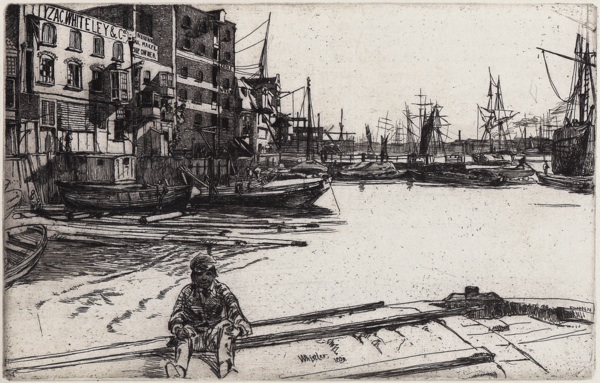Whistler in Limehouse & Wapping

DMW937351 The Lime-Burner, from “A Series of Sixteen Etchings of Scenes on the Thames”, 1859, printed 1871 (etching & drypoint) by Whistler, James Abbott McNeill (1834-1903); 27.9×20.3 cm; Davis Museum and Cultural Center, Wellesley College, MA, USA; Bequest of George H. Webster; American, out of copyright
W.Jones, Limeburner, Wapping High St
American-born artist, James Abbott McNeill Whistler, was only twenty-five when he arrived in London from Paris in the summer of 1859 and, rejecting the opportunity of staying with his half-sister in Sloane St, he took up lodgings in Wapping instead. Influenced by Charles Baudelaire to pursue subjects from modern life and seek beauty among the working people of the teeming city, Whistler lived among the longshoremen, dockers, watermen and lightermen who inhabited the riverside, frequenting the pubs where they ate and drank.
The revelatory etchings that he created at this time, capturing an entire lost world of ramshackle wooden wharfs, jetties, warehouses, docks and yards, are displayed in a new exhibition which opened this week at the Fine Art Society in New Bond St. Rowing back and forth, the young artist spent weeks in August and September of 1859 upon the Thames capturing the minutiae of the riverside scene within expansive compositions, often featuring distinctive portraits of the men who worked there in the foreground.
The print of the Limeburner’s yard above frames a deep perspective looking from Wapping High St to the Thames, through a sequence of sheds and lean-tos with a light-filled yard between. A man in a cap and waistcoat with lapels stands in the pool of sunshine beside a large sieve while another figure sits in shadow beyond, outlined by the light upon the river. Such an intriguing combination of characters within an authentically-rendered dramatic environment evokes the writing of Charles Dickens, Whistler’s contemporary who shared an equal fascination with this riverside world east of the Tower.
Whistler was to make London his home, living for many years beside the Thames in Chelsea, and the river proved to be an enduring source of inspiration throughout a long career of aesthetic experimentation in painting and print-making. Yet these copper-plate etchings executed during his first months in the city remain my favourites among all his works. Each time I have returned to them over the years, they startle me with their clarity of vision, breathtaking quality of line and keen attention to modest detail.
Limehouse and The Grapes – the curved river frontage can be recognised today.
The Pool of London
Eagle Wharf, Wapping
Billingsgate Market
Longshore Men
Thames Police, Wapping
Black Lion Wharf, Wapping
Looking towards Wapping from the Angel Inn, Bermondsey
‘Whistler on the Thames’ is at the Fine Art Society, 148 New Bond St until 9th May
You may also like to read about
Dickens in Shadwell & Limehouse
Madge Darby, Historian of Wapping

























boy can draw.
In interpreting Whistler’s etchings of the Thames it’s worth remembering that he drew directly on the copper plate, in situ. The resulting prints are therefore reversed left to right, which explains why the geography is a bit confused! He took care, however, to write the name boards of riverside warehouses in mirror-writing so that they would read right in the finished print.
I’m finding the details absolutely breathtaking!
Whisler’s river –
out of tangled lines
the mesh of life
sprite
I completely love these pictures… the one of the longshore men… such rustic menace.
Yes indeed Whistler could draw! the Fine Art Society has some particularly beautiful impressions- ‘Lmehouse’ is wonderful: and see lovely zoomable details on website at http://etchings.arts.gla.ac.uk !